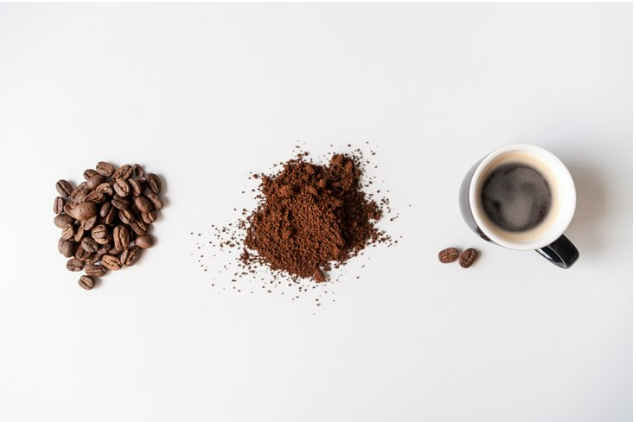Coffee is a beloved beverage enjoyed by millions worldwide. It offers a delightful morning pick-me-up and also a wide range of flavors and aromas to explore. But have you ever wondered what makes a great cup of coffee? In this guide, we will cover everything from the different types of coffee beans, their unique characteristics, the best grinding methods, and proper bean storage techniques. Get ready to lift your coffee experience to the next level and learn about the best coffee beans to add to your breakfast routine!

Understanding Coffee Beans
From the rich flavours of single-origin beans to the complexity of blends. Understanding the nuances of coffee beans is essential for selecting the perfect brew.
Types Of Coffee Beans
1) Single Origin: These beans come from a specific geographic region or even a single farm. They offer a distinct taste, capturing the essence of the region’s soil, climate, and cultivation practices.
Benefits:
- Rich flavours: Single-origin beans showcase the distinct flavours and notes specific to their origin. Whether it’s the fruity sweetness of Ethiopian beans or the earthy tones of Sumatran beans.
- Traceability: With single-origin beans, you can trace the coffee back to its source. This gives you a deeper connection to the coffee-growing regions and supports sustainable farming practices.
2) Blends: Blends are a combination of different coffee beans, crafted to achieve a balanced and consistent flavour profile. Roasters blend beans with varying characteristics to create a well-rounded and enjoyable cup of coffee.
Benefits:
- Complexity and balance: Blends offer a harmonious blend of flavours from different regions. This results in a balanced and refined taste.
- Consistency: Roasters can maintain a consistent flavour profile across batches by using a blend. This ensures that you enjoy the same great taste with each cup.
3) Decaf: Decaffeinated coffee beans undergo a process to remove most of the caffeine content while preserving the flavour. They provide an option for those who enjoy the taste of coffee but prefer to limit their caffeine intake.
Benefits:
- Enjoyment without caffeine: Decaf beans allow you to savor the taste and aroma of coffee without the stimulating effects of caffeine.
- Versatility: Decaf beans are suitable for enjoying a cup of coffee later in the day or for individuals who are more sensitive to caffeine.
4) Specialty and Exotic: Specialty coffee refers to beans that are cultivated, harvested, and processed to meet strict quality standards. Exotic coffee varieties, such as Geisha or Bourbon, offer unique and exceptional flavour profiles, often sought after by coffee enthusiasts.
Benefits:
- Exceptional quality: Specialty and exotic beans undergo rigorous quality control measures, ensuring that you experience the best flavours and aromas.
- Rare and unique flavours: These beans offer distinct taste profiles that can be memorable and provide a coffee experience like no other.
Understanding the different types of coffee beans allows you to explore a diverse range of flavours, choose beans that align with your preferences, and appreciate the craftsmanship that goes into producing each cup of coffee. Whether you prefer the distinct characteristics of single-origin beans, the balance of blends, the decaf option, or the exceptional quality of specialty beans, there’s a coffee type to suit every coffee lover’s taste

Coffee Roasters To Check Out Online:
Although you can pick up a bag of coffee beans from your local supermarket, to get the best-tasting coffee it’s always best to go to a coffee roaster. Here are recommendations:
UK – Top Picks
- Square Mile – If you enjoy your espresso, the Red Brick seasonal blend is a great choice
- Allpress – The Haus Decaf Blend is a nice choice for a decaf
- Carluccios – The Milano beans are a top seller
- Origin – For a filter coffee, Los Altos is very popular
The Art of Grinding: Unlocking Flavour Potential
Grinding your coffee beans correctly can make a world of difference in the taste and aroma of your cup. We’ll dive into the various grind sizes, from coarse to fine, and discuss how they relate to different brewing methods. Whether you’re brewing espresso, pour-over, or French press, we’ll provide you with expert tips to achieve the optimal grind for your desired coffee extraction.
Grind Sizes:
1) Coarse Grind: Coarse grind refers to larger particles that have a noticeable texture. This grind size is for French press and cold brew due to the longer extraction time.
Benefits:
- Longer extraction time: Coarse grind allows for a slower extraction, resulting in a rich and robust cup of coffee.
- Reduced over-extraction: With a larger particle size, the coffee is less likely to become bitter or over-extracted.
2) Medium Grind: Medium grind falls between the coarse and fine grind sizes. It is commonly used for drip coffee makers and pour-over methods like Chemex or V60.
Benefits:
- Balanced extraction: Medium grind provides a balanced extraction, allowing for a well-rounded flavour profile.
- Versatility: This grind size works well with various brewing methods, making it a popular choice for many coffee enthusiasts.
3) Fine Grind: Fine grind consists of smaller particles, resembling sand or table salt. It is best used for espresso machines and moka pots.
Benefits:
- Quick extraction: Fine grind facilitates a faster extraction, which is necessary for espresso brewing.
- Intense flavour: The smaller particle size allows for a higher surface area, resulting in a more concentrated and intense coffee flavour.

Tips for Grinding Coffee:
- 1) Invest in a burr grinder: Burr grinders provide more consistent grind sizes compared to blade grinders, ensuring better extraction and flavour.
- 2) Adjust grind size according to brewing method: Experiment with different grind sizes to find the optimal one for your preferred brewing method.
- 3) Grind before brewing: To preserve freshness and flavour, grind your coffee beans just before you’re ready to brew.
Understanding the art of grinding and selecting the appropriate grind size for your preferred brewing method allows you to unlock the full flavour potential of your coffee beans. Whether you’re aiming for a rich and full-bodied espresso or a bright and clean pour-over, mastering the grind size is a crucial step in your coffee journey. Experiment, fine-tune, and enjoy the remarkable flavours that await you with each perfectly ground cup of coffee.
Storing Coffee Beans: Preserving Freshness and Flavour
Proper storage is key to maintaining the quality and freshness of your coffee beans. We’ll share valuable insights on the best practices for storing your beans, including the importance of avoiding moisture, air, heat, and light. Discover the ideal containers and locations to keep your beans in prime condition, ensuring every cup is as delightful as the first.
- 1) Keep Away from Moisture: Moisture is the enemy of coffee beans as it can lead to deterioration and the loss of flavour. Avoid storing your beans in humid environments such as near the sink or refrigerator.
- 2) Limit Exposure to Air: Oxygen can quickly degrade the quality of coffee beans, causing them to become stale. Store your beans in airtight containers to reduce exposure to air. Choose containers with airtight seals or consider using coffee storage canisters with one-way valves that release carbon dioxide while preventing oxygen from entering.
- 3) Guard Against Heat: Heat can speed up the oxidation process and negatively impact the flavour of your coffee. Avoid storing beans near heat sources like stovetops, ovens, or direct sunlight. Instead, choose a cool and dry spot in your kitchen or pantry.
- 4) Shield from Light: Light can also contribute to the degradation of coffee beans by affecting their chemical composition. Store your beans in opaque containers or dark-colored bags to protect them from light exposure. Avoid transparent or glass containers that allow light to penetrate.
- 5) Store in Whole Bean Form: To preserve the freshness and flavour, it’s recommended to store coffee beans in their whole bean form rather than grinding them in advance. Grinding exposes more surface area to air, which can lead to flavour loss.
- 6) Avoid Freezing and Refrigeration: Contrary to popular belief, it’s not advisable to store coffee beans in the freezer or refrigerator. The moisture and condensation can negatively impact the taste and aroma of the beans. Instead, opt for storing them at room temperature in a suitable container.
- 7) Buy in Smaller Quantities: To ensure the freshest coffee experience, consider purchasing coffee beans in smaller quantities. This allows you to consume them within a reasonable timeframe before they lose their optimal flavour.
By following these storage guidelines, you can protect the freshness and flavour of your coffee beans. This will ensure a delicious cup of coffee every time you brew. Remember, investing in proper storage containers and selecting a cool, dry, and dark location will help preserve the quality of your beans. This will allow you to savour the full potential of your favourite coffee for an extended period.

Conclusion:
With this comprehensive guide, you are well-equipped to embark on a journey into the world of coffee beans. Remember, the key to a fantastic cup of coffee lies not only in selecting the right beans but also in understanding how to grind them correctly and store them with care. Experiment with different types of beans, explore various brewing methods, and savour the rich flavours and aromas that each cup brings. Whether you’re a novice or a seasoned coffee enthusiast, this guide will help you appreciate the art of coffee brewing and elevate your coffee experience to new heights. So grab your favourite beans, fire up your grinder, and savour the joy of a perfectly brewed cup of coffee. Cheers!
